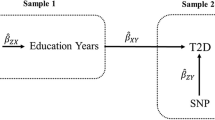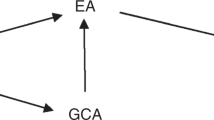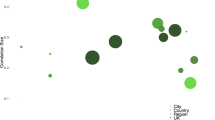Abstract
Educated people are generally healthier, have fewer comorbidities and live longer than people with less education1,2,3. Much of the evidence about the effects of education comes from observational studies, which can be affected by residual confounding. Natural experiments, such as laws that increase the minimum school leaving age, are a potentially more robust source of evidence about the causal effects of education. Previous studies have exploited this natural experiment using population-level administrative data to investigate mortality, and surveys to investigate the effect on morbidity1, 2,4. Here, we add to the evidence using data from a large sample from the UK Biobank5. We exploit the raising of the minimum school leaving age in the UK in September 1972 as a natural experiment6. We used a regression discontinuity design to investigate the causal effects of remaining in school. We found consistent evidence that remaining in school causally reduced the risk of diabetes and mortality in all specifications.
This is a preview of subscription content, access via your institution
Access options
Access Nature and 54 other Nature Portfolio journals
Get Nature+, our best-value online-access subscription
$29.99 / 30 days
cancel any time
Subscribe to this journal
Receive 12 digital issues and online access to articles
$119.00 per year
only $9.92 per issue
Buy this article
- Purchase on Springer Link
- Instant access to full article PDF
Prices may be subject to local taxes which are calculated during checkout



Similar content being viewed by others
References
Lager, A. C. J. & Torssander, J. Causal effect of education on mortality in a quasi-experiment on 1.2 million Swedes. Proc. Natl Acad. Sci. USA 109, 8461–8466 (2012).
Clark, D. & Royer, H. The effect of education on adult mortality and health: evidence from Britain. Am. Econ. Rev. 103, 2087–2120 (2013).
Cutler, D. & Lleras-Muney, A. Education and Health: Evaluating Theories and Evidence (National Bureau of Economic Research, 2006).
Dickson, M. The causal effect of education on wages revisited: the causal effect of education. Oxf. Bull. Econ. Stat. 75, 477–498 (2013).
Fry, A. et al. Comparison of sociodemographic and health-related characteristics of UK Biobank participants with those of the general population. Am. J. Epidemiol. 186, 1026–1034 (2017).
Harmon, C. & Walker, I. Estimates of the economic return to schooling for the United Kingdom. Am. Econ. Rev. 85, 1278–1286 (1995).
Bulik-Sullivan, B. K. et al. LD score regression distinguishes confounding from polygenicity in genome-wide association studies. Nat. Genet. 47, 291–295 (2015).
Conti, G., Heckman, J. & Urzua, S. The education–health gradient. Am. Econ. Rev. 100, 234–238 (2010).
Naess, O., Hoff, D. A., Lawlor, D. & Mortensen, L. H. Education and adult cause-specific mortality—examining the impact of family factors shared by 871 367 Norwegian siblings. Int. J. Epidemiol. 41, 1683–1691 (2012).
Meghir, C., Palme, M. & Simeonova, E. Education, Health and Mortality: Evidence from a Social Experiment (National Bureau of Economic Research, 2012).
Nordahl, H. et al. Education and cause-specific mortality: the mediating role of differential exposure and vulnerability to behavioral risk factors. Epidemiology 25, 389–396 (2014).
Mackenbach, J. P. et al. Variations in the relation between education and cause-specific mortality in 19 European populations: a test of the ‘fundamental causes’ theory of social inequalities in health. Soc. Sci. Med. 127, 51–62 (2015).
Strand, B. H. et al. Educational inequalities in mortality over four decades in Norway: prospective study of middle aged men and women followed for cause specific mortality, 1960–2000. BMJ 340, c654 (2010).
Baker, D. P., Leon, J., Smith Greenaway, E. G., Collins, J. & Movit, M. The education effect on population health: a reassessment. Popul. Dev. Rev. 37, 307–332 (2011).
Spearman, C. ‘General intelligence,’ objectively determined and measured. Am. J. Psychol. 15, 201–292 (1904).
Davey Smith, G. et al. Education and occupational social class: which is the more important indicator of mortality risk? J. Epidemiol. Community Health 52, 153–160 (1998).
Schafer, M. H., Wilkinson, L. R. & Ferraro, K. F. Childhood (mis)fortune, educational attainment, and adult health: contingent benefits of a college degree? Soc. Forces 91, 1007–1034 (2013).
Clouston, S. A. et al. Benefits of educational attainment on adult fluid cognition: international evidence from three birth cohorts. Int. J. Epidemiol. 41, 1729–1736 (2012).
Richards, M. & Sacker, A. Is education causal? Yes. Int. J. Epidemiol. 40, 516–518 (2011).
Davey Smith, G. & Ebrahim, S. Epidemiology—is it time to call it a day? Int. J. Epidemiol. 30, 1–11 (2001).
Leamer, E. Let’s take the con out of econometrics. Am. Econ. Rev. 73, 31–43 (1983).
Deary, I. J. & Johnson, W. Intelligence and education: causal perceptions drive analytic processes and therefore conclusions. Int. J. Epidemiol. 39, 1362–1369 (2010).
Angrist, J. D. & Krueger, A. B. Instrumental variables and the search for identification: from supply and demand to natural experiments. J. Econ. Perspect. 15, 69–85 (2001).
Nguyen, T. T. et al. Instrumental variable approaches to identifying the causal effect of educational attainment on dementia risk. Ann. Epidemiol. 26, 71–76.e3 (2016).
Layard, R. in The Youth Labor Market Problem: Its Nature, Causes, and Consequences (eds Freeman, R. B. & Wise, D. A.) 499–542 (Univ. Chicago Press, Chicago, IL, 1982).
McCulloch, G., Cowan, S. & Woodin, T. The British Conservative Government and the raising of the school leaving age, 1959–1964. J. Educ. Policy 27, 509–527 (2012).
Powdthavee, N. Does education reduce the risk of hypertension? Estimating the biomarker effect of compulsory schooling in England. J. Hum. Cap. 4, 173–202 (2010).
Jürges, H., Kruk, E. & Reinhold, S. The effect of compulsory schooling on health—evidence from biomarkers. J. Popul. Econ. 26, 645–672 (2013).
Collins, R. What makes UK Biobank special? Lancet 379, 1173–1174 (2012).
O’Keeffe, A. G. et al. Regression discontinuity designs: an approach to the evaluation of treatment efficacy in primary care using observational data. BMJ 349, g5293 (2014).
Okbay, A. et al. Genome-wide association study identifies 74 loci associated with educational attainment. Nature 533, 539–542 (2016).
Torssander, J. From child to parent? The significance of children’s education for their parents’ longevity. Demography 50, 637–659 (2013).
McCrary, J. Manipulation of the running variable in the regression discontinuity design: a density test. J. Econom. 142, 698–714 (2008).
Calonico, S., Cattaneo, M. D. & Titiunik, R. Robust nonparametric confidence intervals for regression-discontinuity designs: robust nonparametric confidence intervals. Econometrica 82, 2295–2326 (2014).
Benjamini, Y. & Hochberg, Y. Controlling the false discovery rate: a practical and powerful approach to multiple testing. J. R. Stat. Soc. Ser. B Methodol. 57, 289–300 (1995).
National Life Tables, UK Statistical Bulletins (Office for National Statistics, accessed 21 February 2017); https://www.ons.gov.uk/peoplepopulationandcommunity/birthsdeathsandmarriages/lifeexpectancies/bulletins/nationallifetablesunitedkingdom/previousReleases
Richards, M. & Sacker, A. Lifetime antecedents of cognitive reserve. J. Clin. Exp. Neuropsychol. 25, 614–624 (2003).
Gilman, S. E. et al. Educational attainment and cigarette smoking: a causal association? Int. J. Epidemiol. 37, 615–624 (2008).
Turley, P. Heterogeneous Impacts of Education on Health. PhD dissertation, Harvard Univ. (2016).
Pei, Z., Pischke, J.-S. & Schwandt, H. Poorly Measured Confounders are More Useful on the Left Than on the Right NBER Working Paper No. 23232 (National Bureau of Economic Research, 2017); https://doi.org/10.3386/w23232.
Rothman, K. J., Gallacher, J. E. & Hatch, E. E. Why representativeness should be avoided. Int. J. Epidemiol. 42, 1012–1014 (2013).
Cole, S. R. et al. Illustrating bias due to conditioning on a collider. Int. J. Epidemiol. 39, 417–420 (2009).
Imbens, G. W. & Angrist, J. D. Identification and estimation of local average treatment effects. Econometrica 62, 467–475 (1994).
Clarke, P. S. & Windmeijer, F. Instrumental variable estimators for binary outcomes. J. Am. Stat. Assoc. 107, 1638–1652 (2012).
Deaton, A. Instruments, randomization, and learning about development. J. Econ. Lit. 48, 424–455 (2010).
Imbens, G. W. Better late than nothing: some comments on Deaton (2009) and Heckman and Urzua (2009). J. Econ. Lit. 48, 399–423 (2010).
Rietveld, C. A. et al. GWAS of 126,559 individuals identifies genetic variants associated with educational attainment. Science 340, 1467–1471 (2013).
Hagenaars, S. P. et al. Shared genetic aetiology between cognitive functions and physical and mental health in UK Biobank (N=112 151) and 24 GWAS consortia. Mol. Psychiatry 21, 1624–1632 (2016).
Angrist, J. D., Imbens, G. W. & Rubin, D. B. Identification of causal effects using instrumental variables. J. Am. Stat. Assoc. 91, 444–455 (1996).
Wooldridge, J. M. Asymptotic properties of weighted M-estimators for variable probability samples. Econometrica 67, 1385–1406 (1999).
Solon, G., Haider, S. J. & Wooldridge, J. M. What are we weighting for? J. Hum. Resour. 50, 301–316 (2015).
Canan, C., Lesko, C. & Lau, B. Instrumental variable analyses and selection bias. Epidemiology 28, 396–398 (2017).
Buscha, F. & Dickson, M. The Wage Returns to Education over the Life-Cycle: Heterogeneity and the Role of Experience (Institute for the Study of Labor (IZA), 2015).
Denman, J. & McDonald, P. Unemployment statistics from 1881 to the present day. Labour Market Trends 104, 5–18 (1996).
Cattaneo, M. D., Jansson, M. & Ma, X. rddensity: manipulation testing based on density discontinuity. Stata J. (in the press); https://pdfs.semanticscholar.org/4523/c0a6b2d7c9a802bdbff4941263181701a659.pdf
Keller, M. C. Gene × environment interaction studies have not properly controlled for potential confounders: the problem and the (simple) solution. Biol. Psychiatry 75, 18–24 (2014).
Lee, D. S. & Lemieux, T. Regression discontinuity designs in economics. J. Econ. Lit. 48, 281–355 (2010).
Hernán, M. A. & Robins, J. Instruments for causal inference: an epidemiologist’s dream? Epidemiology 17, 360–372 (2006).
Hayashi, F. Econometrics (Princeton Univ. Press, Princeton, NJ, 2000).
Hausman, J. A. Specification tests in econometrics. Econometrica 46, 1251–1271 (1978).
Altman, D. G. & Bland, J. M. Interaction revisited: the difference between two estimates. BMJ 326, 219 (2003).
Stata Statistical Software: Release 14 (StataCorp, 2015).
Acknowledgements
We thank the Social Science Genetic Association Consortium for providing the coefficients from the educational attainment genome-wide association study, and G. Hemani, L. Paternoster, D. Carslake, J. Bowden, L. Zuccolo, E. Stergiakouli and E. Sanderson for helpful comments on an earlier draft. All mistakes remain our own. The Medical Research Council (MRC) and the University of Bristol fund the MRC Integrative Epidemiology Unit (MC_UU_12013/1 and MC_UU_12013/9). N.M.D. is supported by the Economics and Social Research Council (ESRC) via a Future Research Leaders grant (ES/N000757/1). The research described in this paper was specifically funded by a grant from the ESRC for Transformative Social Science. The funders had no role in study design, data collection and analysis, decision to publish or preparation of the manuscript. This work was carried out using the computational facilities of the Advanced Computing Research Centre (www.bris.ac.uk/acrc/) and the Research Data Storage Facility of the University of Bristol (www.bris.ac.uk/acrc/storage/). This research was conducted using the UK Biobank Resource.
Author information
Authors and Affiliations
Contributions
N.M.D. obtained funding for this study, analysed and cleaned the data, interpreted results, and wrote and revised the manuscript. M.D. interpreted the results and wrote and revised the manuscript. G.J.v.d.B. interpreted the results and wrote and revised the manuscript. G.D.S. obtained funding for this study, interpreted results and wrote and revised the manuscript. F.W. obtained funding for this study, interpreted results and wrote and revised the manuscript.
Corresponding author
Ethics declarations
Competing interests
The authors declare no competing interests.
Additional information
Publisher’s note: Springer Nature remains neutral with regard to jurisdictional claims in published maps and institutional affiliations.
Supplementary information
Supplementary Information
Supplementary Tables 1–14, Supplementary Figures 1–32, Supplementary References, Supplementary Methods.
Rights and permissions
About this article
Cite this article
Davies, N.M., Dickson, M., Davey Smith, G. et al. The causal effects of education on health outcomes in the UK Biobank. Nat Hum Behav 2, 117–125 (2018). https://doi.org/10.1038/s41562-017-0279-y
Received:
Accepted:
Published:
Issue Date:
DOI: https://doi.org/10.1038/s41562-017-0279-y
This article is cited by
-
Association and mediation between educational attainment and respiratory diseases: a Mendelian randomization study
Respiratory Research (2024)
-
Education and medication use later in life and the role of intelligence
The European Journal of Health Economics (2024)
-
Effect of Duration of Education on Sexual Activity and the Mediating Role of Illness in Later Life: A Natural Experiment in English Schooling Reform
Archives of Sexual Behavior (2024)
-
Trends in the ability of socioeconomic position to predict individual body mass index: an analysis of repeated cross-sectional data, 1991–2019
BMC Medicine (2023)
-
Metabolism-related brain morphology accelerates aging and predicts neurodegenerative diseases and stroke: a UK Biobank study
Translational Psychiatry (2023)



